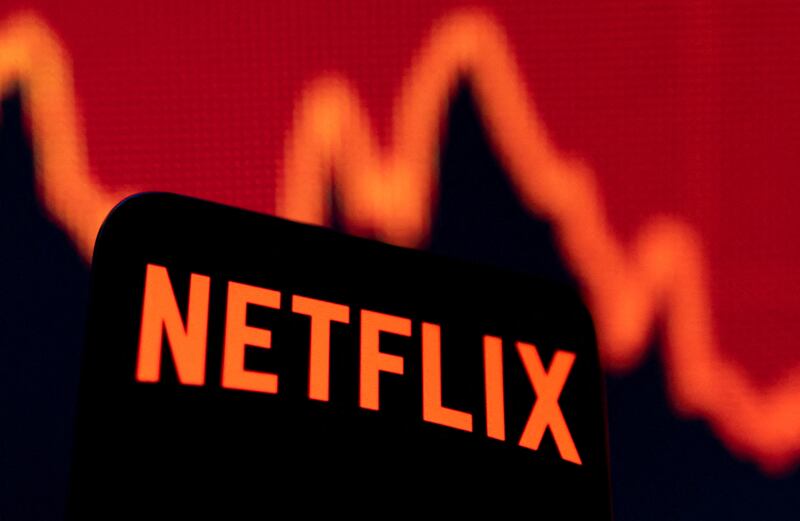For more than 10 years, the number of people subscribing to Netflix grew and grew. Globally, it amassed more than 220 million subscribers and became the world’s leading streaming service. The company clearly saw no reason why the numbers shouldn’t keep increasing, and had expected to add another 2.5 million subscribers in the first quarter of this year. But things swung dramatically the other way.
Netflix has coyly described this as “revenue growth headwinds”, but the quarterly loss of 200,000 subscribers has prompted debate about its prospects and the health of video streaming in general. The news of a further potential loss of two million subscribers in the next quarter resulted in Netflix's share price slumping by 35 per cent, and its value decreasing by some $55 billion. One investment analyst, Kim Forrest at Bokeh Capital Partners, described Netflix as “a poster child for what happens to growth companies when they lose their growth.”
People were quick to blame Netflix’s content for this unexpected turn of events. The world’s richest man, the reliably controversial Elon Musk, tweeted: “The woke mind virus is making Netflix unwatchable.” Translated, he believes that the streaming platform's efforts to broaden its output to appeal beyond a constituency of straight white men is responsible for its decline.
This is highly debatable, but more credible industry observers such as the Financial Times’ Dave Lee suggested that its archive is “lightweight” and its lack of interest in sport is proving unhelpful in terms of platform loyalty.
Netflix’s reputation has been built on huge hits such as Squid Game and Stranger Things, but its habit of cancelling popular, well-received shows such as The Baby-Sitters Club and Archive 81 after one or two seasons has been loudly questioned.
“They have, over years, actively trained their own viewers not to get invested in the content they produce,” tweeted Casey Explosion, a popular Twitch streamer in Ireland. “It feels like they've become notorious for swift and unexpected cancellations … It's done serious damage to their platform.”
There’s a long history of creative professionals and fans expressing displeasure when those kinds of hard-nosed business decisions are made and Netflix, of course, has data about viewership and platform growth that no outside observers have access to.
Unsurprisingly, then, its chief executive Reed Hastings made no mention of video content when discussing the downturn. Instead, the war in Ukraine was partially blamed; the decision to pull out of the Russian market apparently lost Netflix some 700,000 subscribers. In addition, the war’s impact on an already-stuttering global economy is causing consumers to re-examine their relationships with streaming services.
Hastings famously said in 2017 that Netflix’s main competition didn’t come from other streaming services, but from sleep. Five years on, that’s no longer the case. During the pandemic there was a streaming boom as people scoured the internet for ways to fill their time during lockdown, but today, with the world opening up again, there are other things for us all to do.

Video content is also absurdly plentiful and getting more so; the launch of Disney+ in the UAE in June will bring yet more content to an already saturated market.
As households make financial decisions to balance their budgets, subscription services are proving to be low-hanging fruit. Indeed, Netflix’s recent price increases in many territories has caused people to question whether they are getting value for money. TV writer Joel Morris described on Twitter how Netflix is trapped by what he calls the “tap” model, where content is effectively like water.
“If you raise the price you can’t offer 'more', because it already feels more than we need,” he said. “Upping the cost doesn’t make people think ‘I’ll be getting more’ ... they think ‘That’s too expensive.’”
Netflix’s main plan to counteract the fall in subscriber numbers is to increase revenue by forcing people who share their accounts with other households to pay for the privilege.
In the past, Hastings has described such sharing as “something you have to learn to live with”, but with the number of people sharing accounts estimated at about 100 million, Netflix sees them as an untapped source of cash. It has already tested such a scheme in South America, with users in Peru and Chile having to pay a small premium to add profiles to their account, but with dwindling loyalty to streaming services there is a substantial risk of this backfiring.
Even from a technical perspective, there are doubts as to how Netflix could differentiate between normal use — legitimately accessing it on several devices at home, at work and when staying with family — and account sharing.
Its other plan, at some point in the next two years, is to introduce advertising on low-end plans.
“Allowing consumers who would like to have a lower price and are advertising-tolerant to get what they want makes a lot of sense,” said Hastings.
Netflix has also made a move into the gaming industry, with a version of the popular card game Exploding Kittens soon to be launched as a dual TV series and mobile phone app.
But while Netflix’s current difficulties may have briefly caused a smile to flicker on the lips of its big streaming competitors, it’s likely that the problems that have come to get Netflix are coming to get them all.
It’s all very well copying the Netflix model, but what if that model turns out to be a long-term dud?





